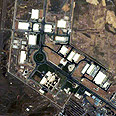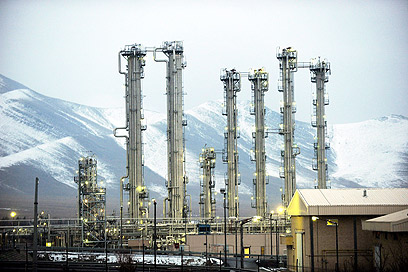
UN nuclear report puts Iran 'mystery man' in spotlight
Mohsen Fakhrizadeh, only Iranian official mentioned in IAEA report's annex, suspected of being key figure in Islamic Republic's nuclear program. Expert: His security was stepped up after killings of nuclear scientists
The shadowy military man believed to be at the heart of Iran's disputed atomic activities likely lives under tight security and in secrecy to shield him against assassins and keep him beyond the reach of UN sleuths, Western nuclear experts say.
A United Nations nuclear watchdog report this week identified Mohsen Fakhrizadeh as a key figure in suspected Iranian work to develop technology and skills needed for atomic bombs and suggested he may still play a role in such efforts.
Related articles:
Fakhrizadeh, reportedly a senior officer in the Islamic state's elite Revolutionary Guards, was the only Iranian official named in a detailed annex of the report, which said Tehran appeared to have worked on designing a nuclear weapon.
"He is viewed as extremely important," US-based proliferation expert David Albright said, referring to assessments of Western intelligence officials.
Fakhrizadeh was named in a 2007 UN resolution on Iran as a person involved in nuclear or ballistic activities. An IAEA report the following year also referred to him briefly.
Iranian media rarely mention him. Four years ago, the semi-official Mehr News Agency described him as a scientist working for the Defense Ministry and a former head of the Physics Research Centre, a body also mentioned in the IAEA's report.
Some Iranian websites said he was a university professor.
But Western analysts acknowledged that little is publicly known about Fakhrizadeh, described by Albright's think tank as a nuclear engineer who has overseen a number of projects related to weaponization research and development.
"He is a mystery man," an official, who declined to be named but is from a country which accuses Tehran of seeking to develop atomic bombs, said.

Arak nuclear facility (Photo: EPA)
Greg Thielmann, of the Washington-based Arms Control Association, said he had never seen a photograph of Fakhrizadeh but that he may still be prominent in Iran's activities.
"He was certainly central to the nuclear weapons program halted in 2003 and I assume he continued to be important in sustaining and perhaps coordinating ongoing work related to future weaponization," Thielmann said.
That the United Nations' International Atomic Energy Agency (IAEA) has "long been seeking to interview him, and the Iranians have been refusing, is telling," he said.
A European-based proliferation analyst said he came up with a "big nothing" when he tried to write a paper on Fakhrizadeh.
"He is the one sort of constant that keeps coming up but I must confess I really don't know much about him."
Albright said he believed Fakhrizadeh's security was stepped up after the killings of nuclear scientists in attacks Iran blames on Israel and other foes.
In July, gunmen shot dead university lecturer Darioush Rezaie in eastern Tehran, the third murder of a scientist since 2009. One was killed in a car bomb, the second by a device detonated remotely.
"I would imagine he is in hiding," Albright said. "But they have to worry because Tehran is not that closed. It is not like Moscow in the Cold War."
Iran denies Western accusations it is trying to acquire the capabilities to build atom bombs, saying such weapons of mass destruction are against Islam and its nuclear work aims at the peaceful generation of electric power.
But the IAEA report, released last Tuesday amid media speculation of Israeli strikes against Iran, lent independent weight to suspicions in the West that Iran's nuclear program ultimately has military goals.
"The report can rationally be explained only if a purpose of these Iranian activities was to develop a nuclear warhead to be delivered by a ballistic missile," a senior Western official said, adding it contained "hard evidence."
Iran has dismissed the report as "politically motivated" and its findings as based on forged evidence.
The IAEA document painted a picture of a concerted weapons program that was halted in 2003 -- when Iran came under increased Western pressure -- but some activities later resumed.
The report does not assert that Iran has resumed a full-scale nuclear program, the Western official said.
But, he added, "Since halting its comprehensive and relatively open program in 2003, Iran has continued to engage in activities that have relevance to the development of a nuclear weapon."
The IAEA's report said Fakhrizadeh was executive officer of the so-called AMAD Plan, which according to its information carried out studies related to uranium, high explosives and the revamping of a missile cone to accommodate a warhead.
The work stopped rather abruptly in late 2003, the agency said, citing information it had received from member states.
But the data also indicated that some of the activities later re-started and Fakhrizadeh "retained the principal organizational role." One country had told the IAEA he now heads the Organization of Defensive Innovation and Research.
"The Agency is concerned because some of the activities undertaken after 2003 would be highly relevant to a nuclear weapon program," the IAEA document said.
One Western diplomat said Fakhrizadeh was the "pervasive thread" in the UN agency's report.
Citing intelligence sources, Albright said Fakhrizadeh had been "extremely upset" about the 2003 order to halt the work. But he said Fakhrizadeh had continued to receive money and run institutes, also suggesting some activities did not stop.
- Receive Ynetnews updates directly to your desktop










